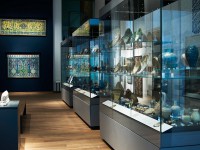Room 31 | Islamic Middle East gallery
Explore artefacts made over a period of more than 1000 years in the heart of the Islamic world.

Arabic holds a particular importance for Muslims, for whom it is the language of God as revealed to the Prophet Muhammad, and expressed in writing in the Qur'an. The standardization of its script occurred over time, and its alphabet was adopted to write other languages of the Islamic world, like Persian, Ottoman Turkish and Urdu.
The Arabic script soon became the most distinctive feature of Islamic art. Calligraphy (beautiful writing) has a prominent place in all arts. Verses from the Qur'an or lines of poetry were frequently inscribed on buildings and objects. Calligraphy was also used to name the patron of a work, explain its function, or describe the society in which it was created.
 Casket lid with huntsmen and animals (EA1987.3)
Casket lid with huntsmen and animals (EA1987.3)
 End of a calligraphic tile panel written in naskhi script (EA1978.1517)
End of a calligraphic tile panel written in naskhi script (EA1978.1517)
 Tile with Qur'anic inscription (EAX.3208)
Tile with Qur'anic inscription (EAX.3208)
 Square tile with holy names in square kufic script (EA2003.57)
Square tile with holy names in square kufic script (EA2003.57)
 Qalamdan, or pen box, with battle scene (EA1971.15)
Qalamdan, or pen box, with battle scene (EA1971.15)
 Penknife from a qalamdan, or pen box (EA1966.58.f)
Penknife from a qalamdan, or pen box (EA1966.58.f)
 Penknife from a qalamdan, or pen box (EA1966.59.e)
Penknife from a qalamdan, or pen box (EA1966.59.e)
 Leaf-shaped spoon from a qalamdan, or pen box (EA1966.60.d)
Leaf-shaped spoon from a qalamdan, or pen box (EA1966.60.d)
 Scissors from a qalamdan, or pen box (EA1966.60.e)
Scissors from a qalamdan, or pen box (EA1966.60.e)
 Reed pen from a qalamdan, or pen box (EA1992.90.d)
Reed pen from a qalamdan, or pen box (EA1992.90.d)
 Bucket with floral and calligraphic decoration (EA1963.17)
Bucket with floral and calligraphic decoration (EA1963.17)
 Footed bowl inscribed with good wishes (EA1971.39)
Footed bowl inscribed with good wishes (EA1971.39)
 Page from a dispersed muraqqa‘, or album, with decorative borders and calligraphy in nasta’liq script (EA2012.52)
Page from a dispersed muraqqa‘, or album, with decorative borders and calligraphy in nasta’liq script (EA2012.52)
Notice
Objects may have since been removed or replaced from a gallery. Click into an individual object record to confirm whether or not an object is currently on display. Our object location data is usually updated on a monthly basis, so contact the Jameel Study Centre if you are planning to visit the museum to see a particular Eastern Art object.
© 2013 University of Oxford - Ashmolean Museum
